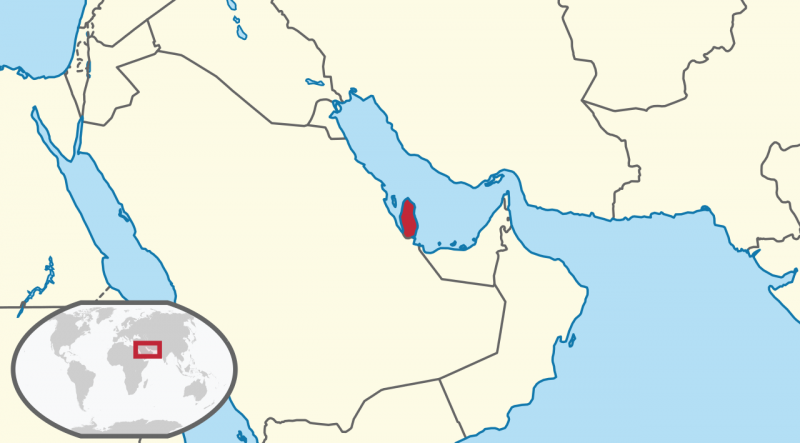
Geography

Source: This image is the intellectual property of TUBS. Redistribution under licence CC BY-SA 3.0
Area: 11,586 km2 (0% water)
Coastline: 563 km
Terrain: mostly flat and barren desert
Highest point: Qurayn Abu al Bawl 103 m (south of the Qatar Peninsula)
Climate: arid; mild winters; very hot and humid summers
Geographical population distribution: More than 75% of the population is concentrated in the south and east parts of the Qatar Peninsula
Natural resources: More than 75% of the population is concentrated in the south and east parts of the Qatar Peninsula
Demographics
Population: 2,881,060 (2020)Annual population growth: 1.7% (2020)
Population estimate in 2025: 3,122,000
Population distribution by age group (2020)0-14 – 14%
15-64 – 85%
65+ – 2%
Fertility rate (births per woman): 1.8 (2019)
Birth rate (births per 1000 people): 9 (2019)
Death rate (deaths per 1000 people): 1 (2019)
Median age: 31.5 years (2015)
Life expectancy (at birth): 80 years (2019)Males – 79 years
Females – 82 years
Net migration: 200,000 people (2017)
Language: Arabic is the official language
Religious groups: Sunni Muslims 63.4%, Catholics Christians 9.0%, Shia Muslim 8.7%, Hindu 2.5%, Other Christians 1.5%, Other Muslims 0.7%, Non-religious/atheists 2.3%, Other religions 2.1%, Unknown 9.9% (2015)
Ethnic groups: Arabs 46.9%, Persians 13.3%, Pakistani 11.9%, Indians 11.8%, Other 16.2% (2013)
Economy
GDP: $144.4 bil (2020)
GDP per capita: $ 50,124.4 (2020)
GDP annual growth rate: -3.6% (2020)
Public debt (% GDP): 53.1% (2019)
Inflation (CPI): -2.5% (2020)
Unemployment: 3.5% (2020) Imports: $29.2 bil (2019)5 largest import partners (% total imports - 2019): United States 18.65%, China 11.95%, Germany 7.14%, United Kingdom 6.63%, India 5.16%
Exports: $72.9 bil (2019)5 largest export partners (% total exports - 2019): Japan 18.64, Korea Rep. 15.59%, China 12.37%, India 12.16%, Singapore 7.57%
Global Competitiveness Report (World Economic Forum)72.9/100 (2019 – position 29/141)
Index of Economic Freedom (Heritage Foundation)72.0/100 (2021 – position 31/180)
Income Inequality Index (Gini – World Bank)-
Prosperity Index (Legatum Institute)66.45/100 (2021 – position 46/167)
Military Power
Active Personnel:14,000Land Force: 10,000
Navy: 2,000
Ai Force: 2,000
Defence expenditure (% GDP):1.5% (2010)
Politics and Government
Form of government: Absolute monarchy
Emir: Tamim bin Hamad Al Thani (2013)Prime Minister: Sheikh Khalid bin Khalifa bin Abdul Aziz Al Thani (2020)
Executive branch: The Emir of Qatar is the country’s head of state and exercises executive authority with the assistance of the Council of Ministers, while the Prime Minister is the head of government and is appointed by the Emir. The rule of the country is hereditary in the family of Al-Thani and the Emir designates his successor among his sons. Members of the Council of Ministers are nominated by the Prime Minister and appointed by the Emir. The Prime Minister or any other Minister may be entrusted by the Emir with leading one or more ministries.
Legislative branch: The Shoura Council is the country’s legislative authority and consists of 45 members. Direct elections are held for 30 of the representatives for a 4-year term; the remaining 15 members of the Shoura Council are appointed by the Emir and they may serve until they resign or until they are relieved from their posts. Nevertheless, legislative elections have never taken place. The Shoura Council has limited legislative authority since the Emir has the ultimate power of ratifying and promulgating laws.
Judicial branch: The Supreme Council of the judiciary was set up in 1999 to ensure the independence of the judiciary and the 9 members of the judiciary’s Supreme Council are appointed by the Emir. Qatar’s court system has three types of courts: civil courts, criminal courts and islamic (sharia) courts. The court system provides three stages of litigation: courts of First Instance, courts of Appeal and the Court of Cassation. The Court of Cassation is the state’s highest court and its judges are nominated by the Supreme Judicial Council and appointed by the Emir. In 2007 Qatar established the Supreme Constitutional Court and the court system also includes administrative and labour courts.
Parliamentary parties: Political parties are banned.
Last elections: Municipal elections 2019 – Turnout 50.1% out of 26,640 votersNext elections: Municipal elections 2023
Rule of Law - Human Rights
Corruption Perceptions Index (Transparency International)63/100 (2020 - position 30/180)
Rule of Law Index (World Justice Project)
-
Global Terrorism Index (Institute for Economics & Peace)
0.023/10 (2019 – position 133/163)
Fragile States Index (Fund For Peace)
44.1/120 (2021 – position 144/179)
Democracy Index (Economist Intelligence Unit)
3.24/10 (2020 – position 126/167)
Press Freedom Index (Reporters Without Borders)
42.60/100 (2021 – position 128/180)
Freedom in the World Index (Freedom House)
25/100 (2021)




